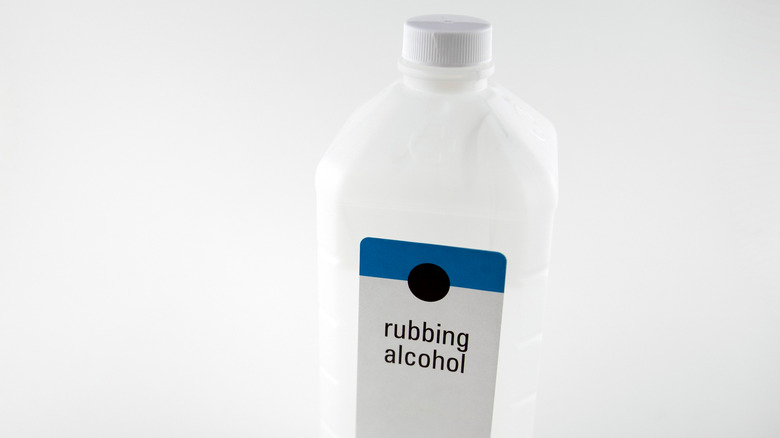Stay Safe From Ticks With These Simple Ingredients
Ticks are a valid threat in every household. They lurk in the garden, hide in the house, and prey on your pets. Come spring, nobody is safe from the pesky pests. But you can protect yourself and your family with a simple homemade solution that not only repels but also kills the bugs. Whether you're dealing with hard ticks or soft ticks, you can always rustle up an effective repellent from simple ingredients in the kitchen and pantry. If you're partial to essential oils or are well stocked on vinegar and bleach, then you already have enough to fight off ticks.
There are many species of ticks you might come across and none of them are safe for humans or animals. They include American dog ticks, blacklegged ticks, brown dog ticks, lone star ticks, soft ticks, and Rocky Mountain wood ticks, among others. The pests are the primary cause of a wide variety of diseases that include Lyme disease, Rocky Mountain spotted fever, Colorado tick fever, and tick-borne relapsing fever (TBRF), to name but a few. Read more to find out which ingredients can keep you safe from ticks, their nasty bites, and the pathogens they carry.
Oregano oil
Oregano oil is one of the most effective essential oils against ticks. You can apply it as a protective spray to repel ticks, a lethal solution that kills the bugs, and as a treatment for tick bites that kills the pathogens that cause diseases. To use oregano oil as a tick repellent, you need a carrier oil, such as olive oil, sunflower oil, avocado oil, jojoba oil, or coconut oil. The carrier oil is used mainly to dilute the essential oil and make it safer to apply to the skin. Start by mixing 6 drops of oregano essential oil into 8 cups of carrier oil. Stir well, then soak a wipe in the mixture and apply it to your uncovered skin. You can also fill a spray bottle with the concoction and spray your clothes before going outdoors.
Oregano oil contains cedrol, a chemical compound that both repels and kills ticks. The essential oil also has high concentrations of carvacrol which can kill Borrelia burgdorferi, the pathogen that causes Lyme disease. That said, you should never use undiluted oregano oil on the skin since it can cause irritations. Also, protect your eyes and nose when spraying it on your face. Oregano oil is toxic to pets even in diluted forms, so take precautions against exposing your pets to the essential oil.
Boric acid
Boric acid is an essential ingredient in many products, such as dish soap, laundry detergent, pesticides, and herbicides. But the mineral also kills both adult and larvae ticks. To apply it around the house, sprinkle the boric acid powder deep within the pile of carpets and rugs and leave it for at least three weeks at a time. Other places to apply the mineral powder include under the fridge, stove, and closet, inside cracks in the wall, and around drainage pipes. In the garden, ticks prefer plants such as hibiscus and azalea. Spreading the powder on dry soil at the base of these plants and bushes will control the pests.
Boric acid is toxic to the ticks that ingest it. It damages their digestive and nervous systems. But the powder is also quite abrasive when it comes into contact with the bugs. It destroys the exoskeletons of hard ticks and leaves them vulnerable to dehydration. However, extra care should be taken when applied around pets and children. If used to control ticks inside of rugs, always brush off the excess powder on top of the rug. The mineral is also toxic to plants, so make sure to remove all traces of the powder from the soil before watering the plants.
Bleach
Bleach is a safe and easy way to get rid of ticks that are either attached to one's skin or hiding in clothes. You can apply a bleach spray on your clothes after coming back from a hike outdoors or spending time in a lawn or garden infested with the pests. To prepare the spray, add 1 cup of bleach to 8 cups of water, shake well, and fill a spray bottle. To kill and remove a tick attached to the skin, soak a swap in the diluted bleach mixture and wipe the tick and the surrounding area with it. Keep applying the solution until the tick stops moving, then remove it with a pair of tweezers. If you want to dispose of a live tick, drop it in a small container that has undiluted bleach for a couple of minutes.
Bleach contains sodium hypochlorite, a powerful chemical with lethal effects on ticks. The ingredient not only kills ticks, but it also kills the pathogens they carry on their body. This can help reduce the risk of infections after applying the bleach treatment. Always dilute bleach before applying it to the skin since, in concentrated form, it is toxic to inhale or ingest and can cause skin burns.
Rubbing alcohol
When it comes to disposing of a tick without making a mess, rubbing alcohol is both convenient and safe. But unlike other ingredients, rubbing alcohol is a targeted method of exterminating ticks that you have already captured and secured. To apply it effectively, you'll need a small container with a lid such as a cup. If the tick is attached to the skin, then you'll need to extract it with a pair of tweezers. Once the tick is out, dab a cotton ball in rubbing alcohol and clean the bite area. Adding some alcohol to the cup, drop the tick in the liquid and put the lid back on. You can apply the same treatment to any tick you find on your clothes or your pets.
Rubbing alcohol contains 70% isopropyl alcohol and it will put an end to ticks. It kills both nymphs and adult ticks quickly by dehydrating their body. But for that to work, the bug has to be fully submerged in the liquid. Isopropyl alcohol shouldn't be used to force an attached tick out of the skin. Doing so could cause the tick to spit toxins and pathogens into the wound.
Lemon juice
When ticks invade your home, lemon juice is an excellent way to deter them. The solution will not kill the bugs, but it can make the place inhospitable for them. To make a lemon juice spray, you'll need three lemons. Fill a pot with 1½ cups of water, then cut the lemons into thin slices and add them to the water. Bring the pot to a boil and let it simmer for a half hour. Setting the concoction aside overnight, remove the lemon slices and fill a spray bottle with the lemon mixture. You can apply it to any place you know ticks might be hiding, including the furniture. When you spray your clothes and your dog with the juicy mixture before going out, it will keep the pests from latching themselves to your clothes or your pet.
Lemon juice is rich in citric acid and ticks have a low tolerance to the chemical compound. And while you can apply it to most surfaces and materials, you need to test it on a small patch before spraying colors or delicate fabrics. Also, keep in mind that cats dislike lemon juice almost as much as ticks, so you shouldn't spritz them with it.
Oil of lemon eucalyptus
The oil of lemon eucalyptus is extracted from the leaves of the lemon eucalyptus tree and has little to do with either lemon or eucalyptus essential oil. OLE has a fresh-smelling scent that fights off ants naturally, but you can also use it to repel ticks. Before you apply OLE, you'll need to dilute it with water or a carrier oil. To prepare an effective yet safe spray, add 15 drops of OLE to ½ cup of water. To get the oil to mix into the water, add 3 milliliters of solubol to the mixture and stir well. Fill a spray bottle with the solution and apply it to yourself before getting into an area infested with ticks.
OLE can only repel ticks, but it doesn't kill them. Also, keep the spray bottle with you when you go out since it requires fresh applications every couple of hours. Although it's safe for most people, it shouldn't be applied to children below three years old. Before you spray yourself with the oil mixture, test it on a small part of your hand and check that it doesn't irritate your skin. Never apply the oil under your clothes.
Neem oil
Neem oil is a natural pesticide processed from the seeds of the neem tree. It can repel and kill ticks but is considered safe to use around pets. As a spray, you can dilute it either with water or with carrier oil. To prepare the spray, stir 2 teaspoons of neem oil into 4 cups of water, mix well, and fill a spray bottle with the mixture. Spray under the shrubs and trees where tall weeds grow. Neem oil is also used to detach a tick latched onto the skin. Apply a drop of the undiluted oil to the tick to force it to let go and then dispose of it safely.
Neem oil works on ticks in different ways. It suffocates the bugs by blocking their breathing holes and prevents their eggs from hatching, thus controlling their numbers. And since it's a natural insecticide, ticks don't develop a resistance or tolerance to the oil. However, neem oil is toxic to bees and other good bugs, so spray it in the garden when these insects are less active. Early mornings and late evenings are the recommended times to apply the eco-friendly pesticide.
Garlic oil spray
Whether growing in the garden or hanging neatly in the pantry, garlic is a potent repellent against many insects. And one of those insects it repels is ticks. When garlic spray is applied to the exposed skin, it will keep ticks away and protect you against their bites. To prepare the homemade garlic spray, peel and finely mince three bulbs of garlic and add them to 1 cup of water in a bowl. Add 2 teaspoons of mineral oil and 1 teaspoon of dish soap to the bowl, mix well, and set them aside overnight. In the morning, strain the mixture, then fill a spray bottle with the liquid. You can also apply it to pets and spray it in the garden or lawn for protection.
Garlic contains sulfur compounds that not only repel but also kill the eggs, larvae, and adult ticks. And since the pests can smell the strong odors of garlic, they'll avoid any area treated with this spray. As with other homemade remedies, test the garlic oil spray on a small patch of the skin first and wait a few minutes. If it doesn't trigger any itching or skin irritation, then it's safe to apply it. Always avoid spraying it near the eyes, nose, or mouth of humans or animals.
Nootkatone
Nootkatone is a chemical compound occurring naturally in the skin of grapefruits and the wood of Alaskan cedar trees. It smells and tastes like grapefruit, which is why it's used to make fragrances and as a food flavor. The repelling qualities of nootkatone were discovered by the CDC and since then it has been approved by the Environmental Protection Agency (EPA) as a tick repellent and pesticide. Its distinctive odor will send the ticks scurrying. If you can't get your hands on the ingredient, you can easily replace it with Alaskan cedar essential oil or grapefruit essential oil. When diluted in water or carrier oil, it can be applied to the skin or clothes to deter ticks.
The grapefruit odor in nootkatone is offensive to ticks. The compound also kills the pests in different ways than how commercial pesticides usually work. However, since it's a relatively new compound, its effects on public health haven't been fully determined yet. The CDC recommends using it in very low concentrations when spraying it on the skin or clothes. It's not advisable to spray it in gardens or on edible plants that will end up on the table.
Apple cider vinegar
Apple cider vinegar is another ingredient with an odor that ticks find too offensive. Even distilled white vinegar will work in a pinch. It's a safe repellent to apply to dogs to prevent tick bites and infections. Preparing an apple cider vinegar spray is quite straightforward. Add 1 cup of vinegar to 4 cups of water and stir well. To reduce the acidity of the mixture and make it safer to apply to the skin, mix in 3 tablespoons of aloe vera and fill a spray bottle. Spray the dog's coat before going out on a hike or allowing them to play in a garden infested with ticks. Also, apply the potent spray to pieces of furniture and nooks and crannies that might attract the pests.
There are many brilliant ways you should be using vinegar to get rid of pests. But against ticks, vinegar sprays are just repellents that won't control or kill the bugs. The acidic liquid can also be used to remove a tick attached to your dog. Soaking a cotton ball in undiluted vinegar and applying it to the tick is a good way to get it off the animal. You can also add vinegar to your dog's drinking water. Mixing 1 teaspoon of vinegar into 4 cups of water will make the pet naturally repel ticks without having to spray them regularly.
Cedarwood oil
The product of Eastern redcedars and other juniper trees, cedarwood oil is a promising ingredient that repels different kinds of ticks. In high enough doses, cedarwood oil can kill tick nymphs as well. You can apply the oil directly on your skin using a cotton ball before going out. If you want to repel ticks in the garden or lawn, mix cedarwood oil with water before spraying it. This is also the recommended way to apply it to your clothing. The oil repellent can protect pets against tick bites and infestations.
Cedarwood oil absorbs the moisture out of ticks, causing dehydration. Exposure to the undiluted oil can suffocate adult ticks and dissolve the body of the nymphs and eggs. However, the repelling qualities of the oil tend to fade quickly. Regular applications are required to keep ticks at bay. Always avoid applying it near the eyes, nose, or mouth, and protect the same areas in your dog as well.
Citronella and thyme oils
Both citronella and thyme oils are known to repel ticks with different levels of efficacy. So combining both ingredients can help you maximize your success at deterring various species of hard and soft ticks. There are different types of thyme oils on the market, but both red thyme and creeping thyme oils are the most effective when dealing with the bugs. To make the spray, add 15 drops of citronella oil and 5 drops of thyme oil to a cup of water. To help the oil disperse in the water, add a teaspoon of dish soap and mix well. Fill a spray bottle with the liquid and apply it to the exposed skin before venturing outside.
Thyme oil contains carvacrol and thymol, and citronella oil contains citronellol and geraniol. All of these compounds work together efficiently to repel ticks and keep them from crawling on your skin. However, exposure to thymol can cause irritation to the skin, nose, or eyes. So avoid inhaling the spray or applying it near the eyes. For safety reasons, test the spray on a part of the leg or arm before applying it to make sure it won't irritate the skin.
Geranium oil
Both geranium oil and rose geranium oil are efficient tick repellents that can be used safely on humans and dogs. Both oils contain the same repelling properties, although rose geranium oil is the more aromatic of the two. For this recipe, you'll also need a carrier oil such as almond oil and, to give the spray a pleasant odor, replace tap water with floral water. In a bowl, mix 30 drops of rose geranium oil, 2 tablespoons of carrier oil, and 1 cup of floral water. Fill a spray bottle with the repellent and apply it to your clothes and uncovered skin. To protect your dog, spray their legs, belly, and back of the neck.
One of the active ingredients in geranium oil is a chemical called (-)-10-epi-γ-eudesmol. This chemical can repel more than 90% of ticks. However, the spray fades quickly, especially on windy days, so repeat applications every hour or so. Proper care should be taken to protect the eyes, mouth, and nose when spraying yourself and your dog. Never use geranium oil on cats, since this essential oil is toxic to your feline friend.
Diatomaceous earth
If spraying chemicals on yourself, your pets, and your furniture isn't an ideal way to deal with ticks, then food-grade diatomaceous earth is the eco-friendly solution you want. The white powder is a surefire way to kill ticks around the house. More importantly, it doesn't require mixing or preparing. Just pouring the powder in the corners, on windowsills, and under the furniture is enough to safeguard the place. You can also rub the powder into the fur of your pets to ensnare and terminate ticks. Diatomaceous earth doesn't contain chemicals that contaminate the environment and is safe to apply around the house, on the lawn, and on animals.
Diatomaceous earth is a mechanical way of killing ticks. When the bugs come into contact with the grainy powder, the sharp edges of the grains damage their body leading to dehydration and death. Make sure you're using food-grade diatomaceous earth and not feed-grade or industrial-grade products. The food-grade product is the safest one to use around people and animals. Also, keep in mind that the powder is only effective when it's dry, so if it gets wet, apply it again on dry surfaces. Don't use it on animals with sensitive skin and always wear a mask when applying it to avoid inhaling the fine material.
Cinnamon oil
Besides its many medicinal properties, cinnamon oil has a strong odor that repels ticks. But unlike other essential oils that fade away quickly, cinnamon oil can stay effective for about two hours after application. To prepare a cinnamon oil repellent, you'll need to dilute it in a carrier oil. The essential oil doesn't dissolve well in water even when dish soap is mixed in. For every 10 drops of carrier oil, add 1 drop of cinnamon oil, mix well, then fill a spray bottle with the mixture. Spray the oil on shady areas on the lawn and under shrubs where ticks might be hiding.
Cinnamon oil is the secret weapon you need to keep ticks out of your yard and garden. And since it lasts longer than many other treatments, you won't have to repeat applications so often. That said, you should keep your dog away from any treated area because cinnamon oil is toxic to dogs. Always take precautions when mixing and applying the oil to protect yourself against skin rashes and burns.















